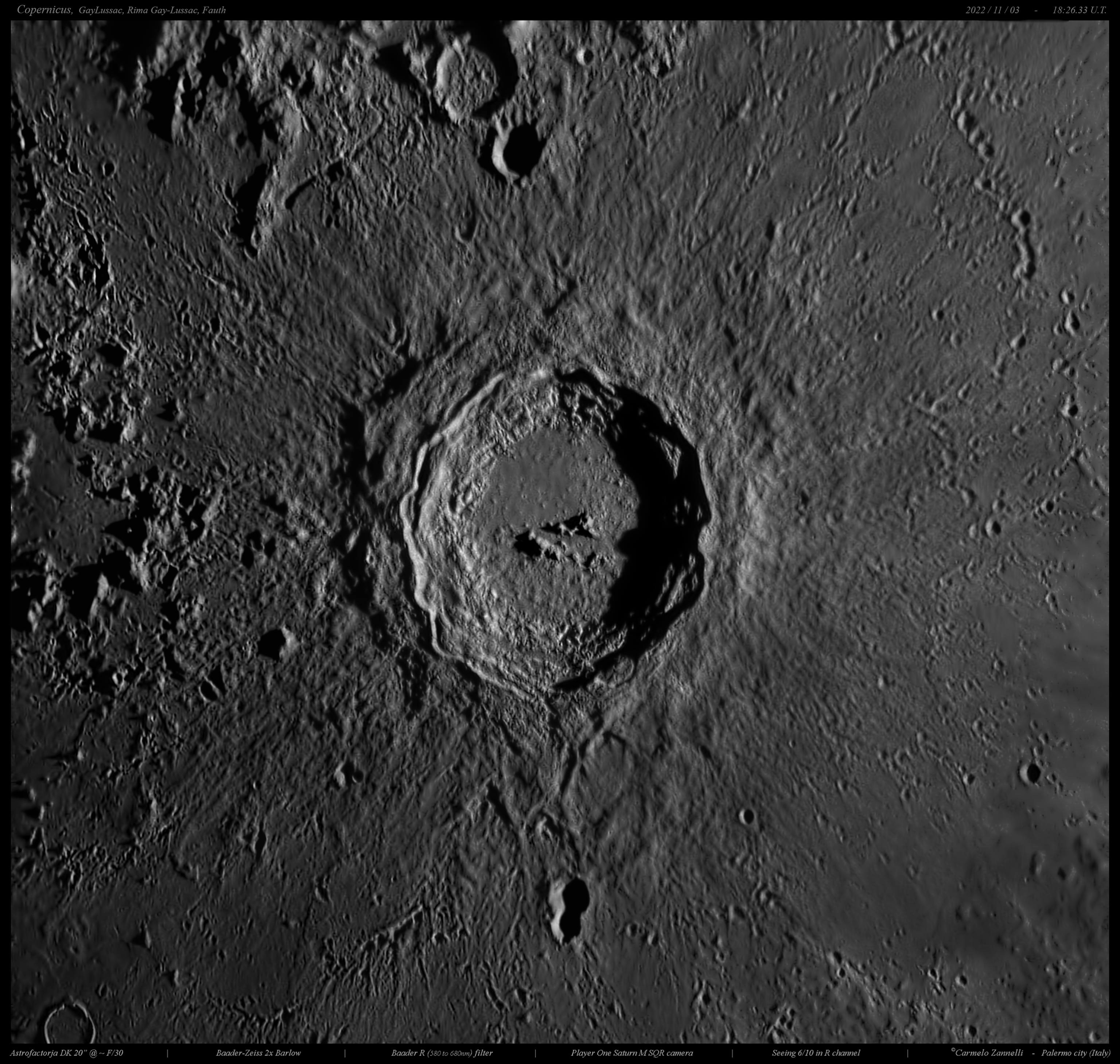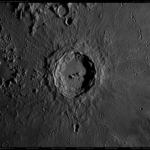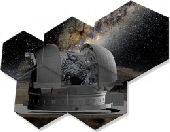Italiano:
Il cratere lunare “Copernico” (o Copernicus) è un cratere lunare di 96,07 km situato nella parte nord-occidentale della faccia visibile della Luna, nella porzione orientale dell’Oceanus Procellarum.
Questo cratere è stato dedicato all’astronomo polacco Niccolò Copernico dal gesuita italiano Giovanni Riccioli.
Copernicus è uno dei crateri più evidenti ed è visibile anche con un piccolo binocolo, puntando leggermente a nord-est del centro della faccia visibile della Luna.
Ha un’età stimata in 800 milioni di anni, ed individua l’inizio dell’Era Copernicana nell’ambito della scala dei tempi geologici lunari. Per la sua età relativamente recente, Copernico mostra poche tracce di erosione e i dettagli della sua struttura sono affilati e ben marcati.
Il bordo ha una forma lievemente esagonale e le pendici interne sono terrazzate. Le pendici esterne si estendono per una trentina di chilometri nel mare circostante, circa un chilometro più in basso. All’interno si distinguono tre sistemi di terrazzature e una frana a forma di arco prodotta dai detriti provenienti dalle pendici.
La raggiera di questo cratere si estende fino a 800 km nel mare circostante, e in numerose locazioni i raggi piegano ad angolo invece di proseguire diritti.
Piccola nota “storica”: Nel 1966 l’interno di questo cratere fu fotografato da uno dei primi satelliti lanciati dalla Terra verso l’orbita lunare, il “Lunar Orbiter 2”. Una di queste foto, tra le prime a mostrare dettagli del suolo lunare da distanza ravvicinata, suscitò scalpore e fu indicata come Immagine del Secolo.
Dettagli Tecnici:
Telescopio Astrofaktorja DK20″ @ ~ F/27 – Player One Saturn M camera – Baader-Zeiss Abbe Barlow 2x – Baader RGB filters – Seeing ~ 6/10 (max.) in R band – sito: Palermo @ my personal Observatory.
*************************************************************************************************
English:
The lunar crater “Copernicus” is a lunar crater of 96.07 km located in the northwestern part of the visible face of the Moon, in the eastern portion of the Oceanus Procellarum.
This crater was dedicated to the Polish astronomer Nicolaus Copernicus by the Italian Jesuit Giovanni Riccioli.
Copernicus is one of the more prominent craters and is visible even with small binoculars, pointing slightly northeast of the center of the visible face of the Moon.
It has an estimated age of 800 million years, and identifies the beginning of the Copernican Era within the lunar geological time scale. For its relatively recent age, Copernicus shows few traces of erosion and the details of its structure are sharp and well marked.
The edge has a slightly hexagonal shape and the internal slopes are terraced. The outer slopes extend some thirty kilometers into the surrounding sea, about a kilometer below. Inside there are three systems of terraces and an arch-shaped landslide produced by debris from the slopes.
The radial pattern of this crater extends up to 800 km into the surrounding sea, and in many locations the rays bend at an angle instead of going straight.
Small “historical” note: In 1966 the inside of this crater was photographed by one of the first satellites launched from the Earth into lunar orbit, the “Lunar Orbiter 2”. One of these photos, among the first to show details of the lunar surface at close range, caused a stir and was designated Image of the Century.
Technical details:
Astrofaktorja DK20″ telescope @ ~ F/27 – Player One Saturn M camera – Baader-Zeiss Abbe Barlow 2x – Baader RGB filters – Seeing ~ 6/10 (max.) in R band – site: Palermo @ my personal Observatory.


